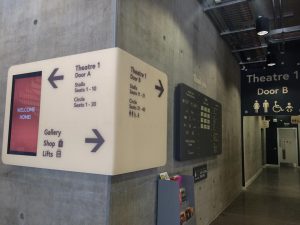What is Wayfinding?
Comments Off on What is Wayfinding?Put simply, the answer to the question “what is wayfinding?” is “the efficient movement of people in places and spaces”. It was Kevin Lynch who very first coined the word ‘wayfinding’ in his 1960 book The Image of the City. Where he discussed how users understood their surroundings in constant and expected ways. As a result his work had important influence in the field of urban planning and environmental psychology.
Since the word was first coined, wayfinding has evolved into a common component of buildings and urban environments across the world. It has developed into a behavioural science, using strategies which aid human navigation.
However many people still don’t truly understand the concept of wayfinding. The most common misconception is that it is just signage. It is true that it often leads to signage – but this a small component of a typical strategy.
Manoeuvring the streets of a foreign city or the corridors of an alien building can be difficult, and consequently can fill you with ease or frustration. This is due to the visual language that communicates how we navigate a given terrain. How a person manages to get from one place to another effectively without any problems is down to the how well a particular system works.
Why do you need Wayfinding?
Over the last few decades wayfinding has developed into a strategic service, which has important implications for urban environments. In today’s busy environments wayfinding is crucial to avoid chaos and confusion.
An understanding of human behaviour is essential to wayfinding. The perception of information within a built environment allows humans to navigate. As humans we have developed cognitive processes which help us orientate ourselves within built environments. An effective strategy understands these basic needs for navigation, applying them to our environments and therefore easing the process.
The ideal wayfinding system will allow the users to not need to think and to travel intuitively towards their destination. Those users who experience a seamless journey are much more likely to appreciate their surroundings and leave with a positive experience. A strong strategy will add value to a particular service or brand. Wayfinding can become part of the marketing process, delivering a positive experience to all users.
So what is wayfinding? Experts who understand wayfinding are essentially problem solvers, they provide a strategy which communicates a clear and consistent message to specific users. Providing communication clarity in signage is ensured through solid wayfinding techniques. Embracing human beings in built navigation process, putting in place systems that are understood intuitively. By ensuring an environment is maximised for human navigation this provides value to a given location or building. Positive user memory, prompting people to think of a building fondly and want to visit again. Finally, it allows you to understand the potential of your environment, maximising business objectives.
Wayfinder Ltd is the leading independent consultancy and can provide you with strategy and implementation throughout the UK.
Mike Slater (MD)
Wayfinder Ltd Ltd


